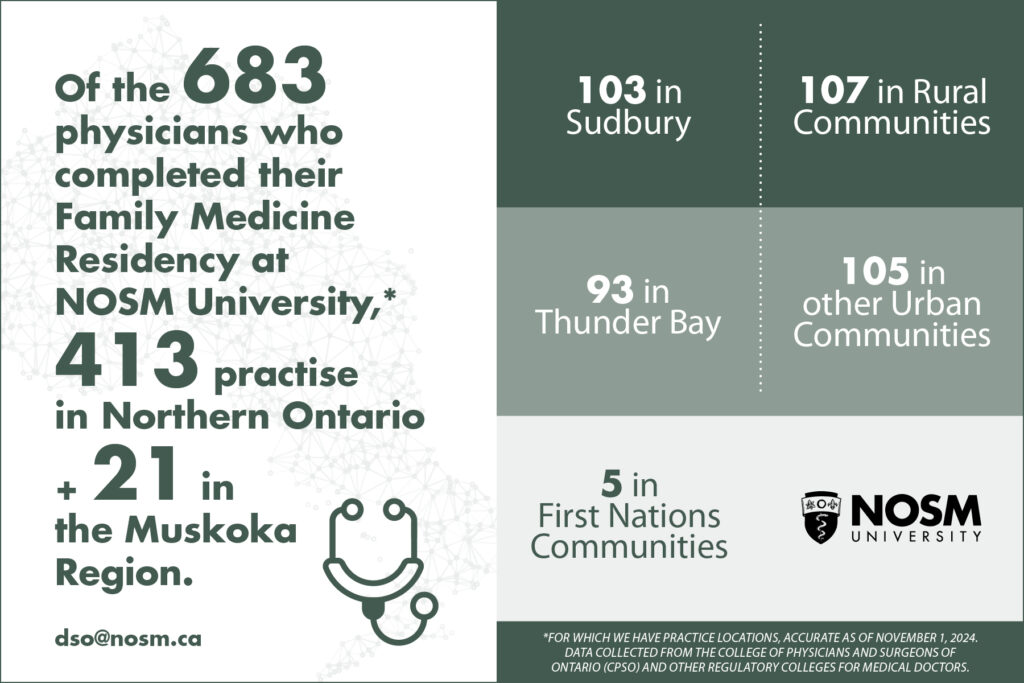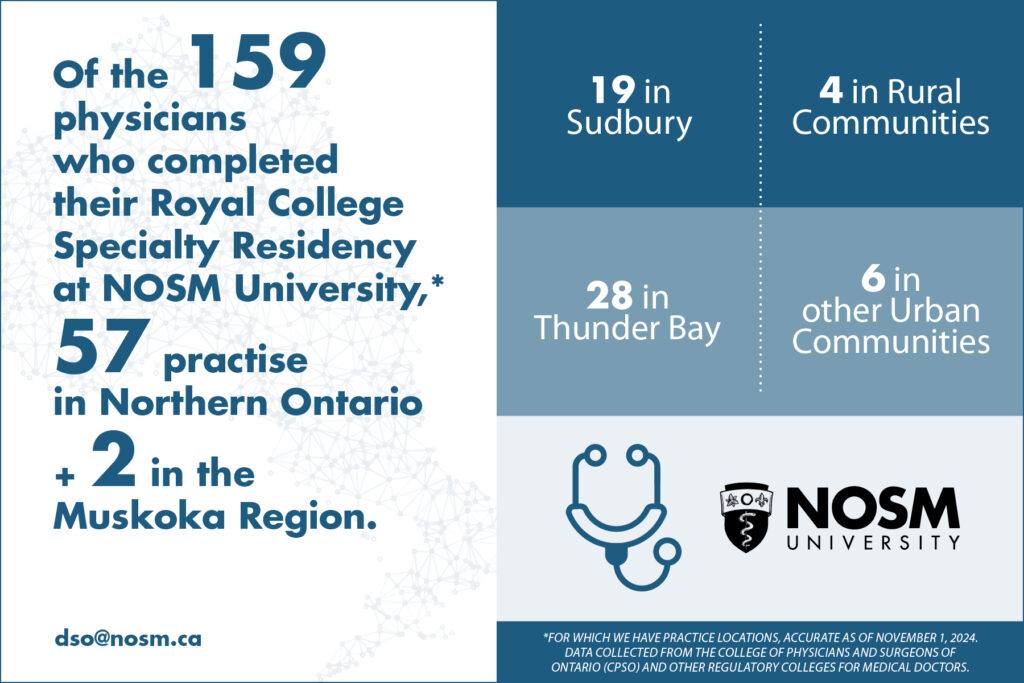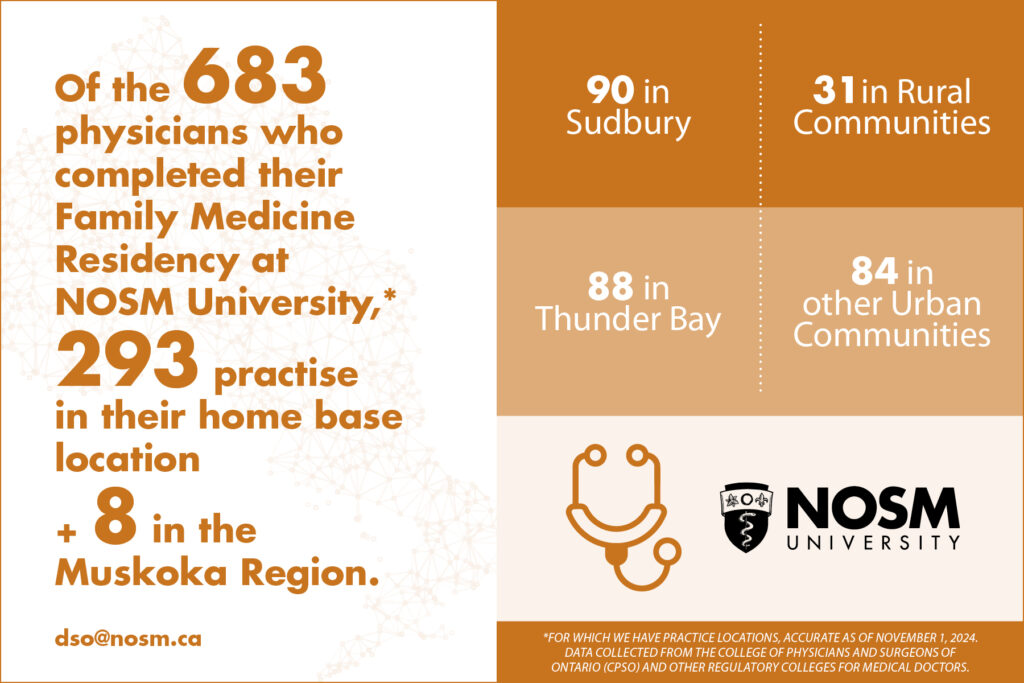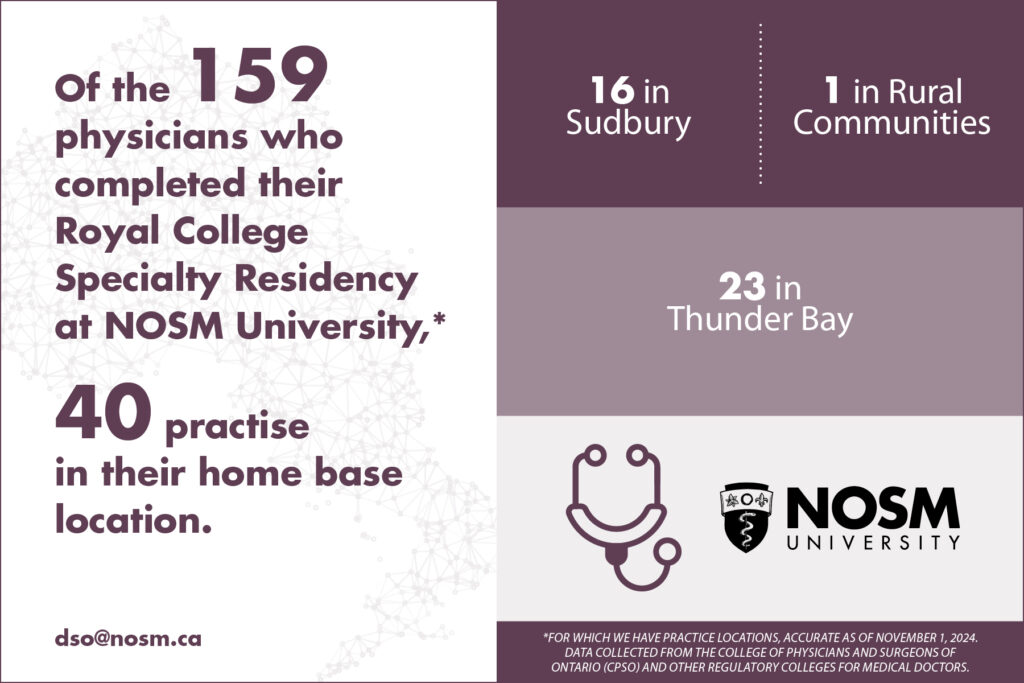Where are NOSM University Grads Working?
What do we know?
In the autumn of each year, we update the data from the NOSM University tracking study to share our understanding of how many of NOSM University’s learners have entered into practice in Northern Ontario.
After a student graduates with their medical degree, they have postgraduate training to complete which can be anywhere from 2 to 9 years depending on whether one chooses family medicine or another specialty like internal medicine, general surgery, pediatrics, psychiatry or a subspecialty area of practice. This is depicted in timeline below. Many learners who have completed their undergraduate degree at NOSM University have not yet completed their postgraduate training. All of the data below reflects physicians who have completed their MD degree and their postgraduate training and have entered into practice.
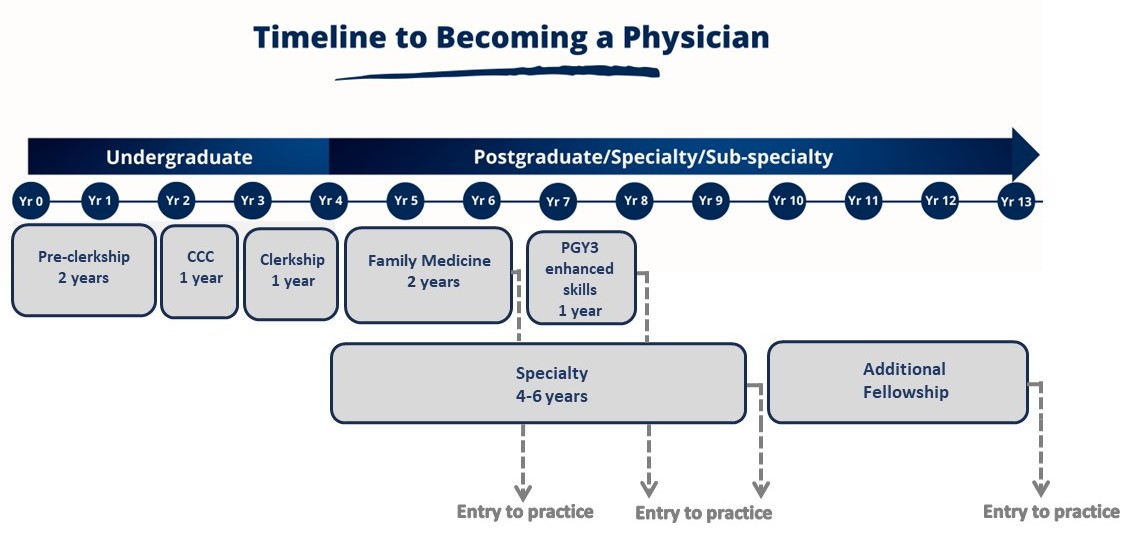
The data below is updated as of November 2024
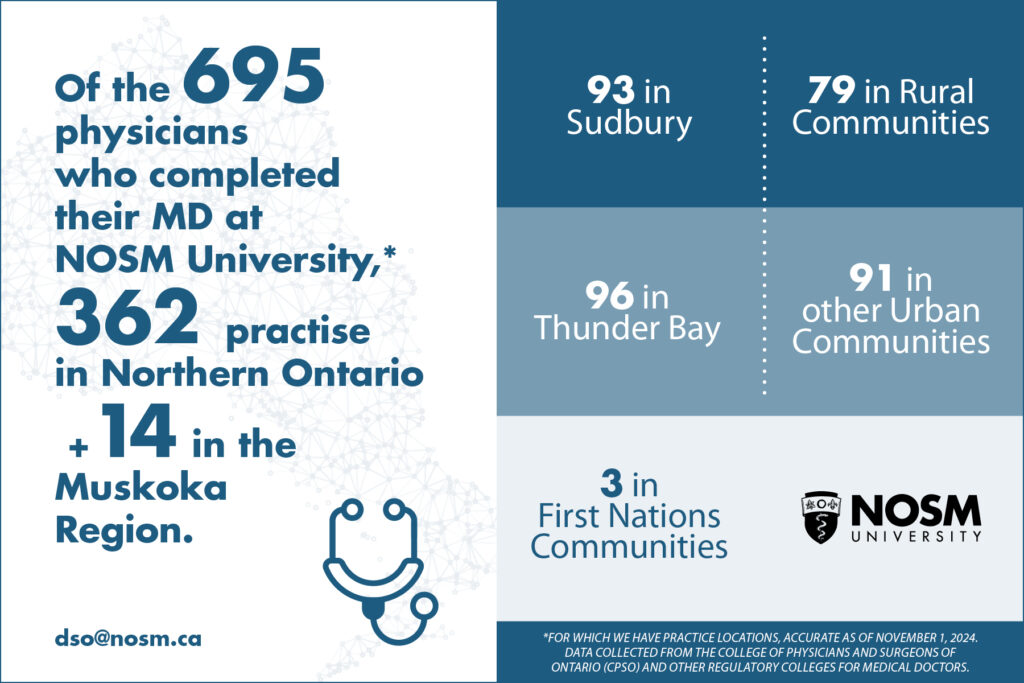 |
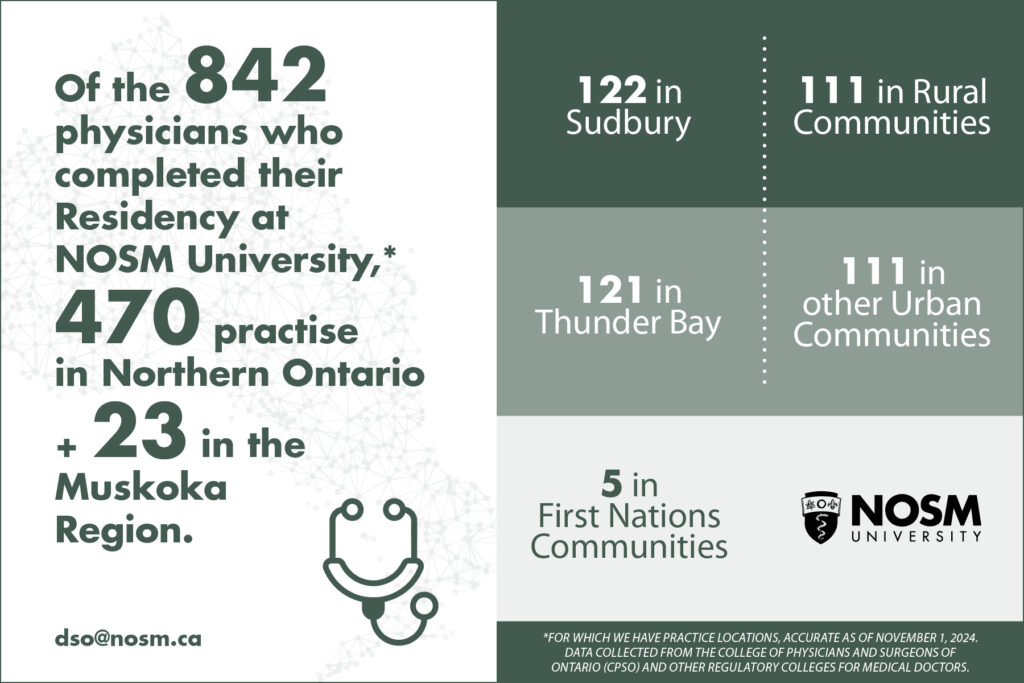 |
|
| Since the first graduating class in 2009 there are 695 physicians who have completed their MD degree at NOSM University who have now entered into practice and for whom we have practice locations.
Approximately 52% (362) of this cohort are in practice in Northern Ontario. Of those who have stayed in Northern Ontario, approximately 19% (69) are in rural communities. |
Since 2008, 56% (470) of the 842 medical residents who have completed their postgraduate training with NOSM University have stayed in Northern Ontario for practice. Of those who have stayed in Northern Ontario, approximately 23% (111) are in rural communities.
Note that the first cohort to graduate from NOSM U undergraduate MD degree was in 2009 and the first cohort of NOSM family medicine postgraduate trainees was in 2008 when NOSM took over the prior NOMP and NOMEC programs. |
|
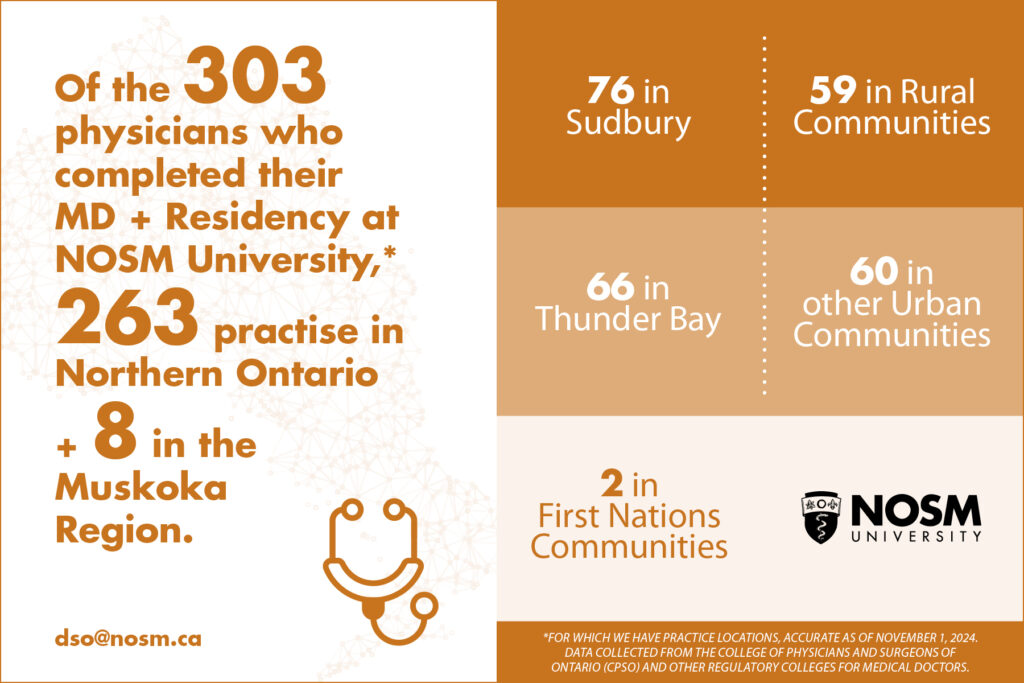 |
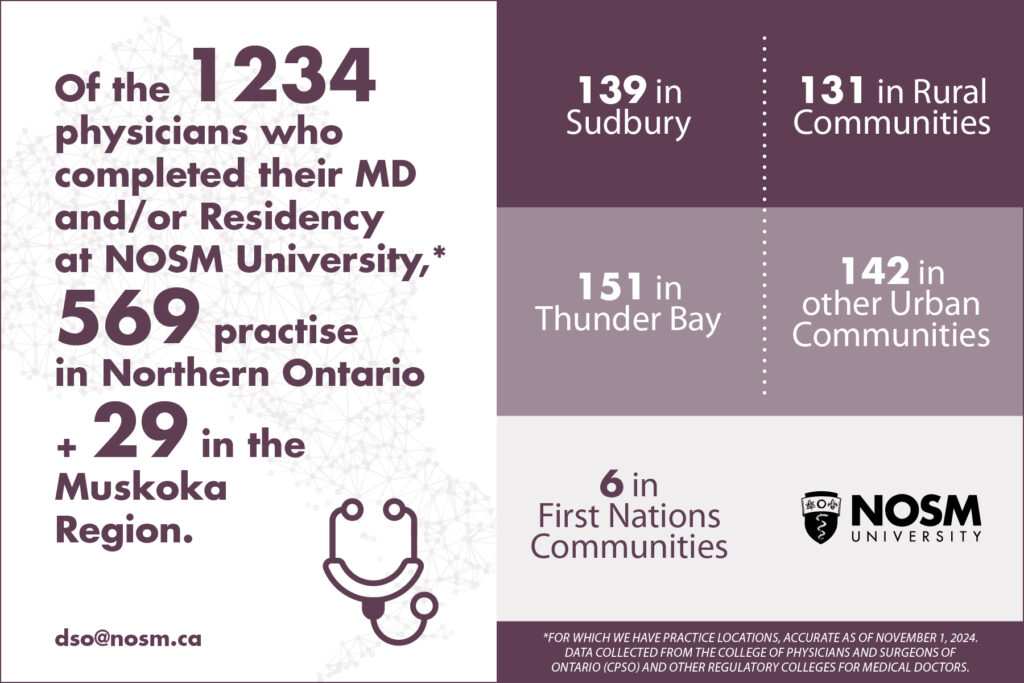 |
|
| Since 2011, there have been 303 physicians who have completed BOTH their undergraduate AND their postgraduate training with NOSM University and have entered into practice. Of these, 87% (263) of the total, have stayed to practice in Northern Ontario. 19% (59) of the group of physicians who have stayed in Northern Ontario are in rural communities.
. |
Since 2008, 1234 physicians have completed EITHER their undergraduate or postgraduate training OR both with NOSM University. Of these, 46% (or 569) of the total have stayed to practice in Northern Ontario. Notably, 131 of those who have remained in Northern Ontario have entered practice in rural communities, accounting for 23% of the physicians who stayed in the region.
Note that the first cohort to graduate from NOSM U undergraduate MD degree was in 2009 and the first cohort of NOSM family medicine postgraduate trainees was in 2008 when NOSM took over the prior NOMP and NOMEC programs. |
|
|
|
|
|
|
|
|
Background Information
Cohorts: The data comes from the NOSM U “tracking study” and includes all NOSM Undergraduate Medical Education (UME) graduates and all post graduate trainees who completed their training with NOSM since 2008. The first NOSM charter class graduated in 2009. The earliest time for that cohort to complete their training and enter practice was 2011 for those who did family medicine programs.
![]() Defining Northern, Urban and Rural: For the purposes of understanding the information below, it is also important to note that Northern Ontario is defined as north of (and including) Parry Sound. NOSM U has teaching sites in Bracebridge, Parry Sound, Huntsville and Midland, and several NOSM U graduates work in those communities but they are not included in the data as having a clinical practice in “Northern Ontario”.
Defining Northern, Urban and Rural: For the purposes of understanding the information below, it is also important to note that Northern Ontario is defined as north of (and including) Parry Sound. NOSM U has teaching sites in Bracebridge, Parry Sound, Huntsville and Midland, and several NOSM U graduates work in those communities but they are not included in the data as having a clinical practice in “Northern Ontario”.
“Other urban communities” are defined as North Bay, Timmins and Sault Ste Marie.
Rural communities in Northern Ontario are considered to be all other communities that are not urban, so all but Sudbury, Thunder Bay, Timmins, North Bay, and Sault Ste Marie.
Indigenous Community Health Practice
NOSM University uses data from the College of Physicians and Surgeons of Ontario (CPSO) to determine a physician’s main practice address, but recognizes there are gaps in the data. This data does not accurately capture where NOSM U graduates may be working as part of their work in a First Nation community.
NOSM University recognizes the contributions of physicians to First Nation and Métis communities. At NOSM University, we know of several graduates are working in rural and remote communities and providing care to area First Nations in their community catchment area. For instance, physicians with a practice location in Sioux Lookout provide care to many remote First Nations, physicians with a practise location in Kenora may provide care to one of several Treaty 3 communities in the Kenora area, physicians in Wawa provide care to people in Michipicoten First Nation, and so on.
NOSM Grad Data 2023
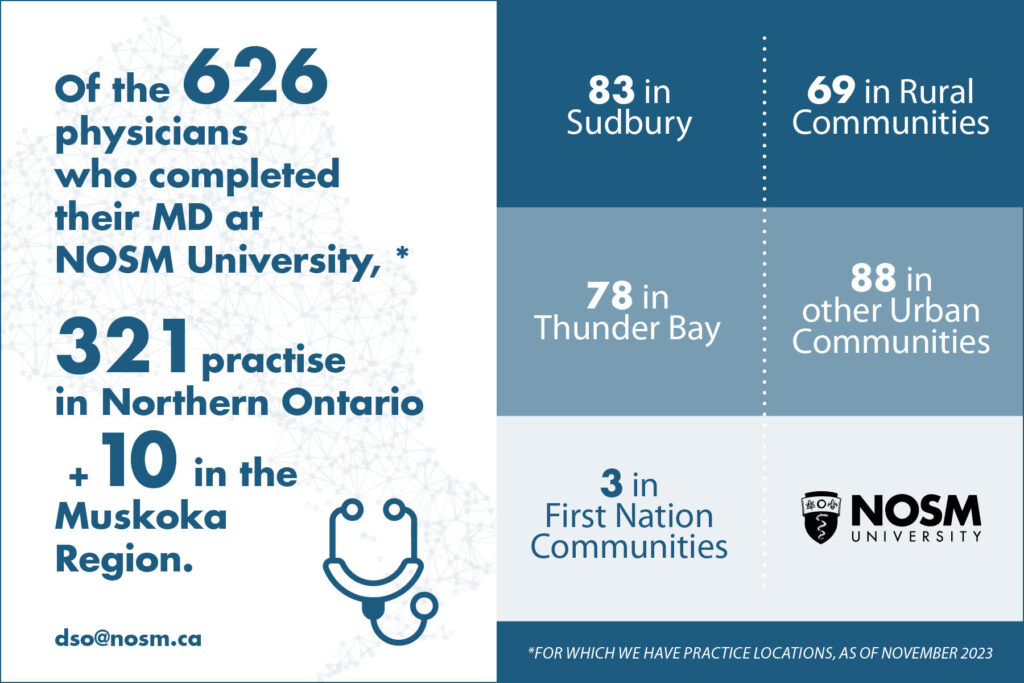
There are 626 physicians who have completed their MD degree at NOSM University since the first graduating class in 2009 who have now entered into practice and for whom we have practice locations. Approximately 51% (321) of this cohort are in practice in Northern Ontario. Of those who have stayed in Northern Ontario, approximately 11% (69) are in rural communities. |
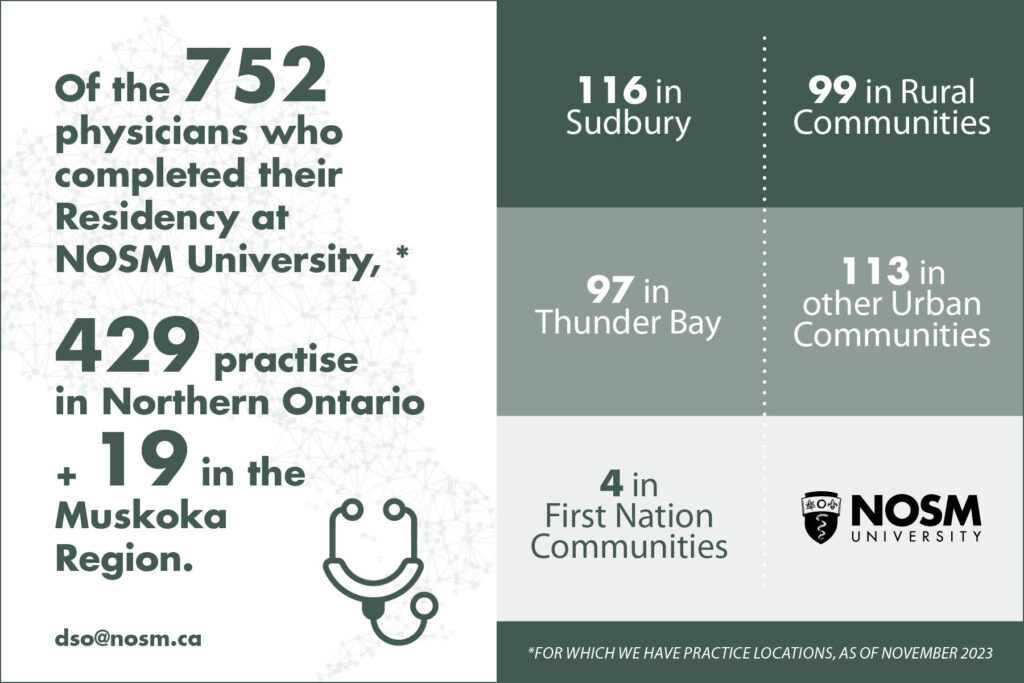
57% (429) of the 752 medical residents who have completed their postgraduate training with NOSM University have stayed in Northern Ontario for practice. |
|
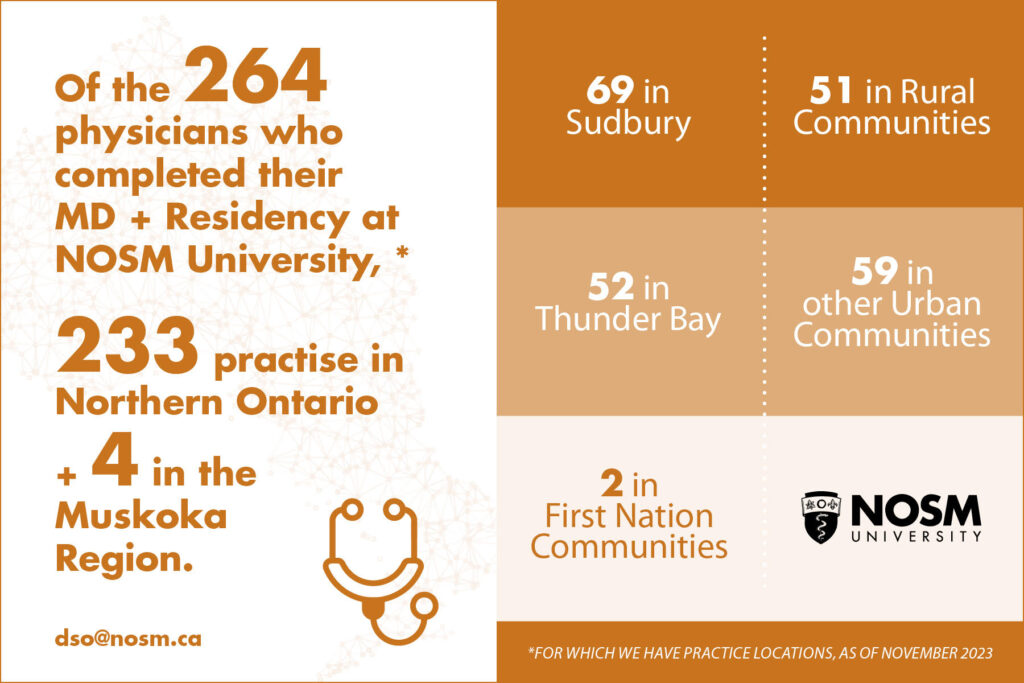
Since 2011, there have been 264 physicians who have completed BOTH their undergraduate AND their postgraduate training with NOSM University. Of these 88% (233) of the total, have stayed to practice in Northern Ontario. 19% (51) of the physicians who have stayed in Northern Ontario are in rural communities. |
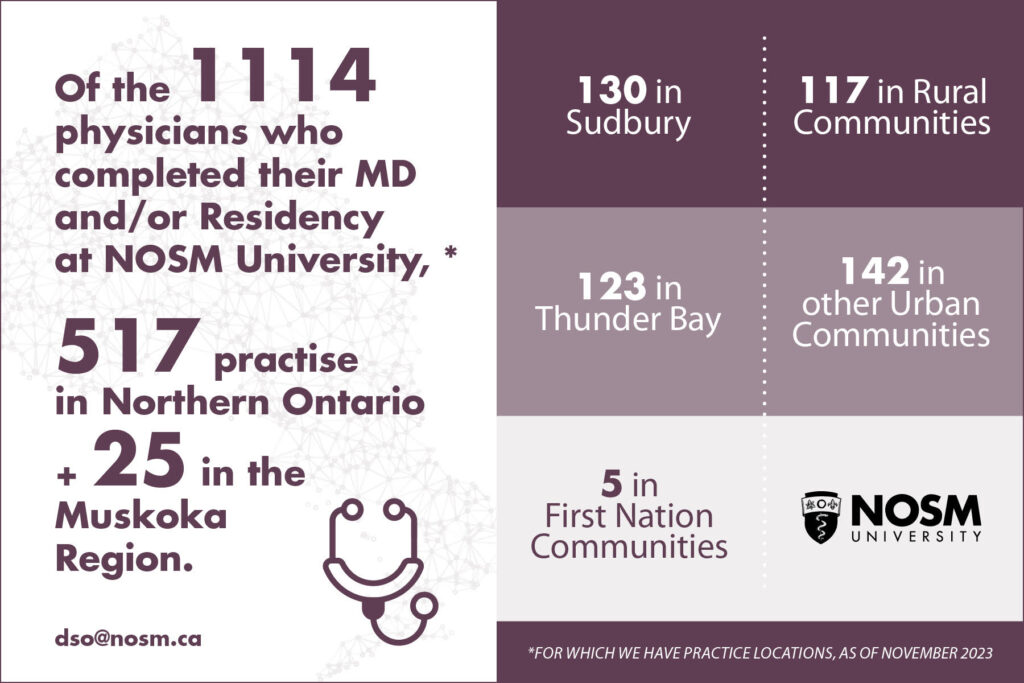
Since 2008, 1114 physicians have completed EITHER their undergraduate or postgraduate training OR both with NOSM University. Of these, 46% (or 517) of the total have stayed to practice in Northern Ontario. Notably, 117 of those who have remained in Northern Ontario have entered practice in rural communities, accounting for 23% of the physicians who stayed in the region. |
NOSM Grad Data 2022
The information below reflects data as of November 2022.
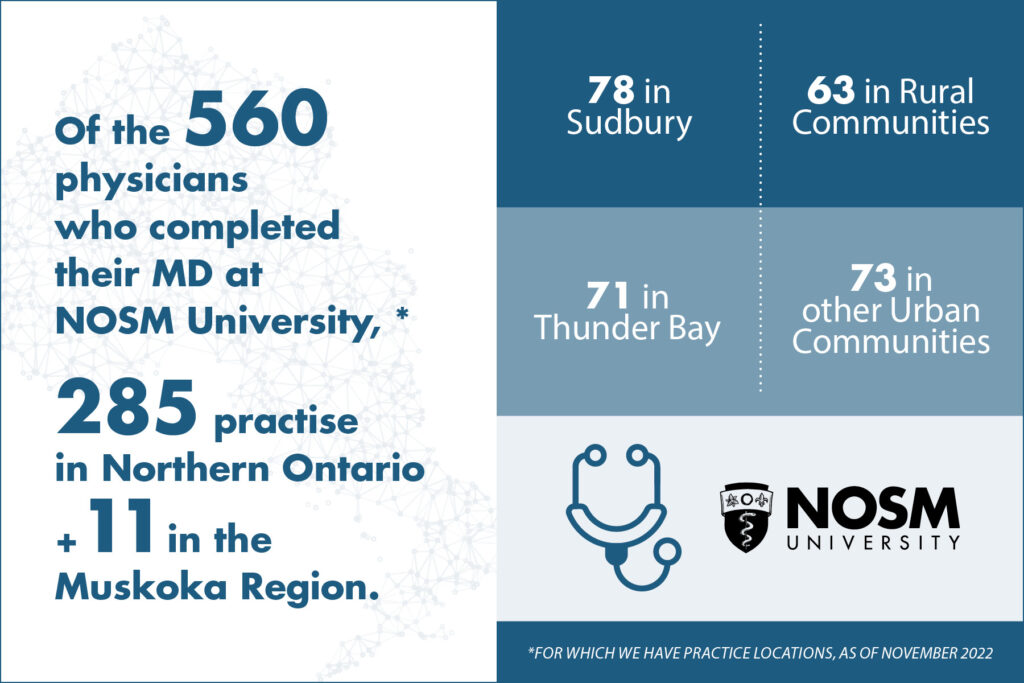 |
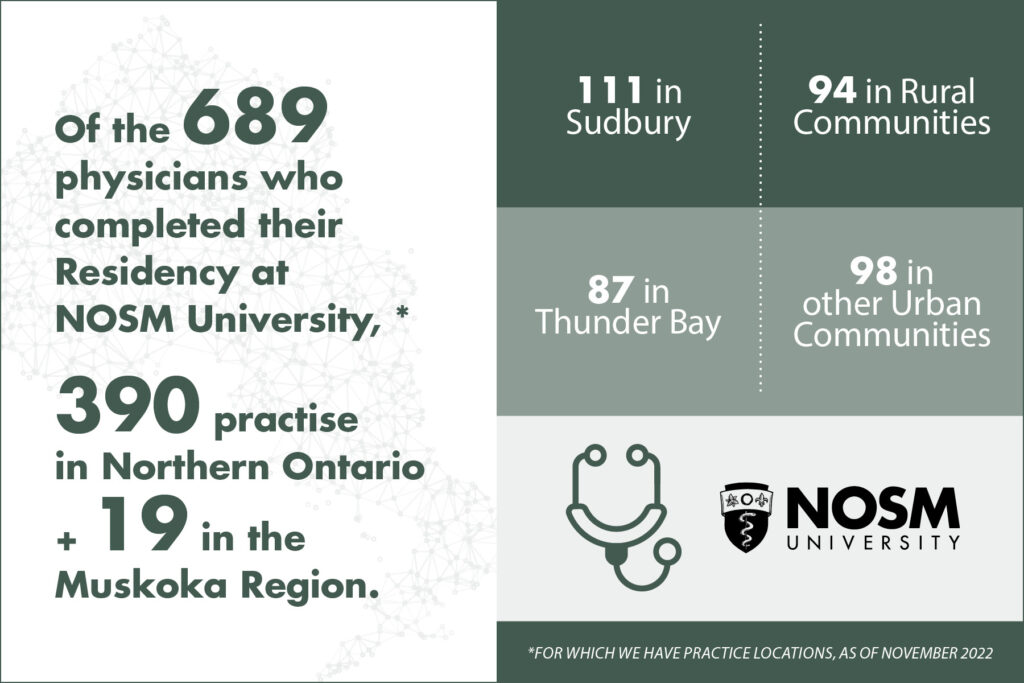 |
|
|
There are 560 physicians who have completed their MD at NOSM University since the first graduating class in 2009 for whom we have practice locations. Approximately 51% of this cohort are in practise in Northern Ontario. Of those who have stayed in Northern Ontario, approximately 22% are in rural communities. |
Postgraduate training is the training that happens after completion of the medical degree. This training can be anywhere from 2-8 years depending on whether one chooses Family Medicine or another specialty like Internal Medicine, General Surgery, Pediatrics, Psychiatry, or a subspecialty. Many learners who have completed their undergraduate degree at NOSM University have not yet have completed their postgraduate training. 56% of those who have completed their postgraduate training with NOSM University have stayed in Northern Ontario for practise. | |
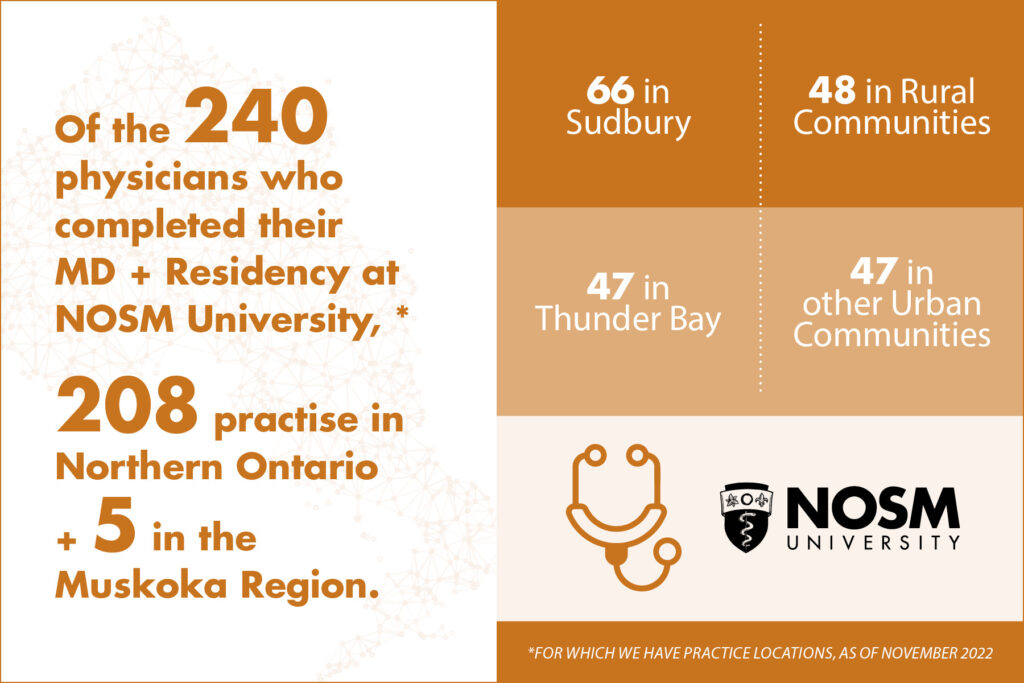 |
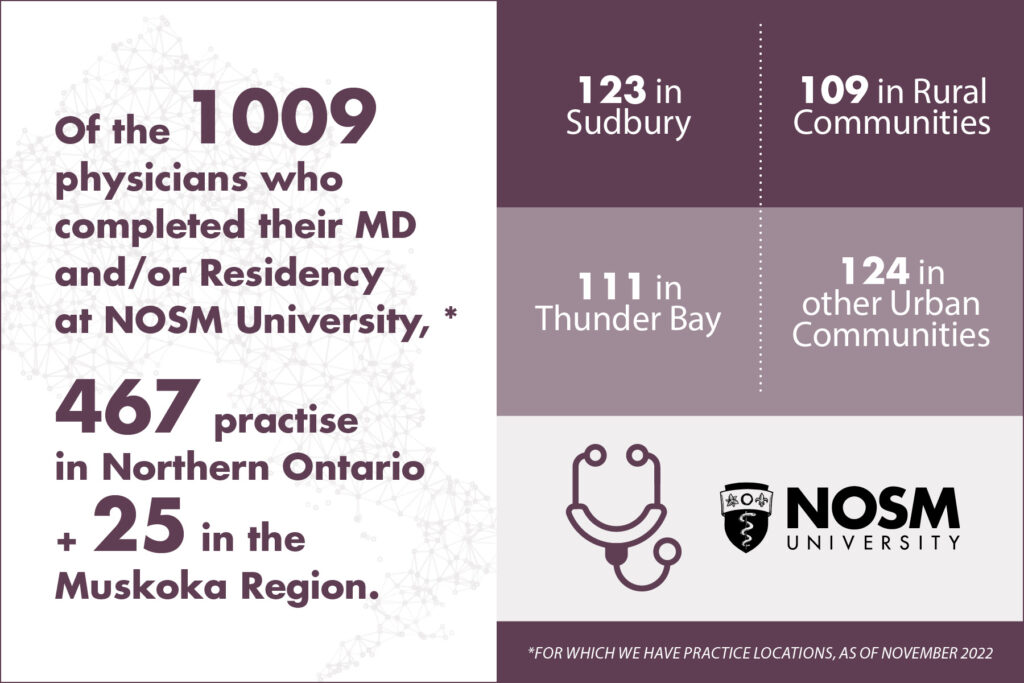 |
|
|
Since 2011, there have been 240 physicians who have completed BOTH their undergraduate AND their postgraduate training with NOSM University. Of these, 208 or 87% of the total, have stayed to practice in Northern Ontario. Forty-eight (23%) of the physicians who have stayed in Northern Ontario are in rural communities. |
Since 2008, 1009 physicians have completed either their undergraduate or postgraduate training or both with NOSM University. Of these, 467 (or 46% of the total) have stayed to practice in Northern Ontario. 109, or 23% of those who have stayed in Northern Ontario have entered practise in rural communities. |
NOSM Grad Data 2021
The information below reflects data as of November 2021.
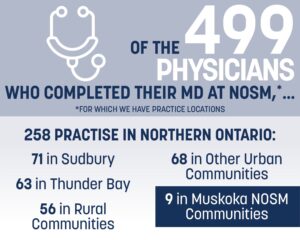 |
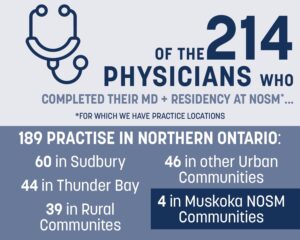 |
|
|
499 physicians completed their MD at NOSM U since the first graduating class in 2009, and for whom we have practise locations. Approximately 52% of this cohort are in practise in Northern Ontario.
|
|
Since 2011, there have been 214 physicians who have completed BOTH their undergraduate AND their postgraduate training with NOSM U. Of these, 189 or 88% of the total, have stayed to practise in Northern Ontario. 39 or 18% of these physicians have entered practise in rural communities in Northern Ontario. |
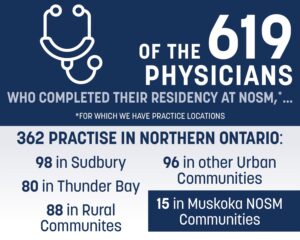 |
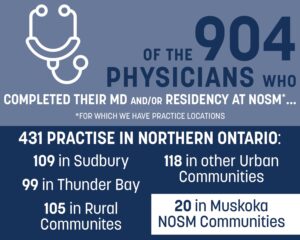 |
|
|
Postgraduate training is the training that happens after completion of the medical degree. This training can be anywhere from 2-8 years depending on whether one chooses Family Medicine or another specialty like Internal Medicine, General Surgery, Pediatrics, Psychiatry, or a subspecialty. Many learners who have completed their undergraduate degree at NOSM U have not yet have completed their postgraduate training. 58% of those who have completed their postgraduate training with NOSM have stayed in Northern Ontario for practise. |
Since 2008, 904 physicians have completed either their undergraduate or postgraduate training or both with NOSM U. Of these, 431 (or 48% of the total) have stayed to practise in Northern Ontario. 105, or 24% of these have entered practise in rural communities.
|
|
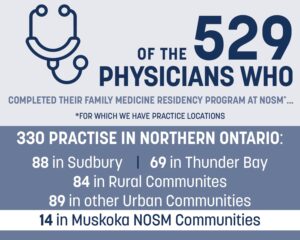 |
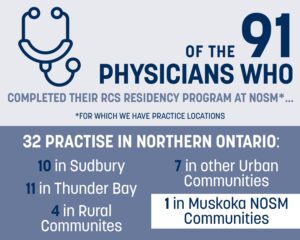 |
|
| Since 2008, 529 Family Physicians have completed their training with NOSM U, and of these 330 (or 62%) have remained in Northern Ontario to practise. 84 (25%) of these physicians practise in rural communities in Northern Ontario. | Since NOSM’s inception, 91 physicians have completed specialty training with NOSM U and of those who have completed their training and entered into practise, 32 (35%) have stayed in Northern Ontario. | |
| Of note, when NOSM, now NOSM University, was established there were two residency programs – Northwestern Ontario Medical Program (NOMP) and Northern Ontario Medical Education Corporation (NOMEC) in Thunder Bay and Sudbury respectively. The family medicine residents in these programs completed their training as NOSM family medicine graduates (2008) prior to the first cohort of graduating NOSM UME learners graduating in 2009. This means that the data above regarding family medicine residency includes 67 residents who entered the NOMP and NOMEC residency training programs but were considered NOSM family medicine graduates two years later when their training was completed. | ||
NOSM Grad Data 2020
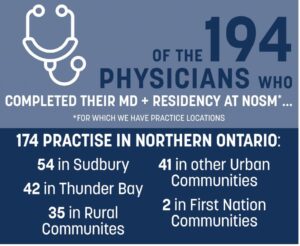 |
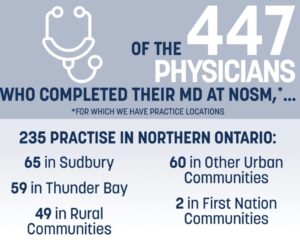 |
| Of those learners who did both their undergraduate and their postgraduate training at NOSM U, 89% have stayed in Northern Ontario. | Of those who have done their undergraduate MD training at NOSM U (some of whom will have done their postgraduate training here, some will have done it at another institution), approximately 52% have stayed in Northern Ontario. |
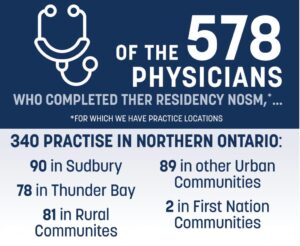 |
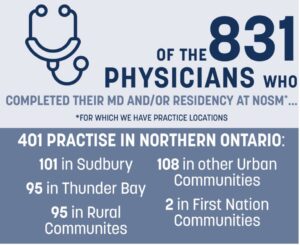 |
| Of those who have done their postgraduate (specialty) training at NOSM U 60% have stayed in Northern Ontario. | Of the 831 unique medical learners completing a program at NOSM U (either undergraduate or postgraduate), approximately 50% have stayed in Northern Ontario. |
NOSM Alumni and Students Share Their Experiences
Read inspirational stories of Indigenous NOSM U alumni: Dr. Elaine Innes and Dr. Zoe Michano-Furlotte.
Dr. Crystal Boulianne and Dr. Shyanne Fournier share what it means, as NOSM University alumni, to practice medicine in French.
Alumni, Dr. Lily DeMiglio and Dr. Adam Moir share their joy in rural practice.


